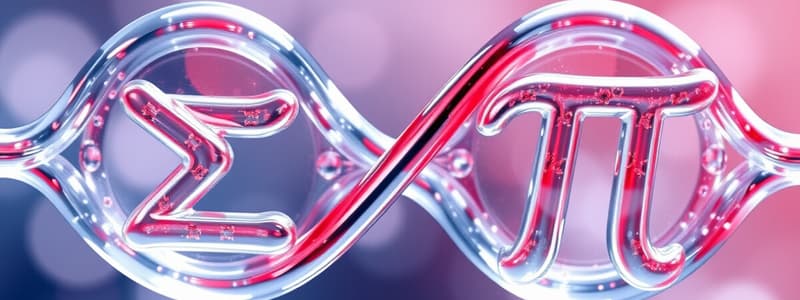Podcast
Questions and Answers
What type of bond is formed by the end-to-end overlap of atomic orbitals?
What type of bond is formed by the end-to-end overlap of atomic orbitals?
- Sigma bond (correct)
- Ionic bond
- Pi bond
- Hydrogen bond
Which of the following statements about sigma bonds is true?
Which of the following statements about sigma bonds is true?
- Only present in double bonds
- Formed from sideways overlap of 'p' orbitals
- Triple bonds contain no sigma bonds
- All single bonds are sigma bonds (correct)
How many pi bonds are present in a triple bond?
How many pi bonds are present in a triple bond?
- 3
- 1
- 0
- 2 (correct)
Which type of overlap is responsible for the formation of pi bonds?
Which type of overlap is responsible for the formation of pi bonds?
What is the composition of a double bond?
What is the composition of a double bond?
In a molecule with one double bond and one single bond, how many sigma bonds would be present?
In a molecule with one double bond and one single bond, how many sigma bonds would be present?
What is the maximum number of pi bonds that can be formed from two atomic orbitals overlapping laterally?
What is the maximum number of pi bonds that can be formed from two atomic orbitals overlapping laterally?
When analyzing a molecule with a triple bond, what is the total count of sigma bonds and pi bonds combined?
When analyzing a molecule with a triple bond, what is the total count of sigma bonds and pi bonds combined?
If a molecule consists of three single bonds and one double bond, how many total sigma bonds are present?
If a molecule consists of three single bonds and one double bond, how many total sigma bonds are present?
How many pi bonds exist in a molecule with two double bonds?
How many pi bonds exist in a molecule with two double bonds?
Flashcards are hidden until you start studying
Study Notes
Sigma and Pi Bonds
- Sigma bonds result from end-to-end overlap of atomic orbitals, including hybrid orbitals.
- All single bonds between atoms are classified as sigma bonds.
- In double and triple bonds, the initial bond formed is always a sigma bond, while additional bonds differ in type.
- Pi bonds arise from the sideways overlap of 'p' orbitals, contributing to the bond formation in specific scenarios.
- Pi bonds are exclusively present in double and triple bonds; they cannot exist in single bonds.
- A double bond consists of one sigma bond and one pi bond, creating a stronger bond due to the combination of both types.
- A triple bond contains one sigma bond and two pi bonds, resulting in an even stronger interaction between the bonded atoms.
- Identifying sigma and pi bonds in molecules requires examining the bond types present within the structure.
Sigma and Pi Bonds
- Sigma bonds result from end-to-end overlap of atomic orbitals, including hybrid orbitals.
- All single bonds between atoms are classified as sigma bonds.
- In double and triple bonds, the initial bond formed is always a sigma bond, while additional bonds differ in type.
- Pi bonds arise from the sideways overlap of 'p' orbitals, contributing to the bond formation in specific scenarios.
- Pi bonds are exclusively present in double and triple bonds; they cannot exist in single bonds.
- A double bond consists of one sigma bond and one pi bond, creating a stronger bond due to the combination of both types.
- A triple bond contains one sigma bond and two pi bonds, resulting in an even stronger interaction between the bonded atoms.
- Identifying sigma and pi bonds in molecules requires examining the bond types present within the structure.
Studying That Suits You
Use AI to generate personalized quizzes and flashcards to suit your learning preferences.




